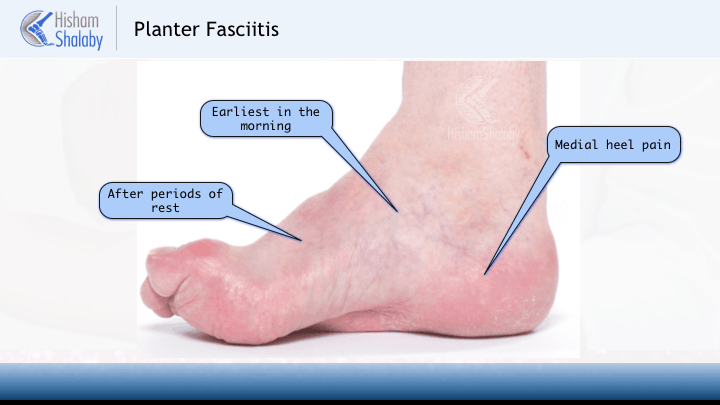What is Plantar Fasciitis?
The plantar fascia is a thick cord of tissue that runs in the foot from the heel to the toes. It helps to support the arch of the foot and is put under strain when weight-bearing.
The condition “Plantar fasciitis” describes pain coming from the fascia, mainly from the attachment to the heel bone.
It is thought to be a fatigue failure of the fascia where the body cannot keep up with the repair process. It tends to be more problematic in patients who are overweight, in athletes and in those with other foot deformities.
Symptoms of Plantar fasciitis
Pain is the main symptom. This can be anywhere on the underside of your heel but can commonly be in one spot.
The pain is often worst when you take your first steps on getting up in the morning, or after long periods of rest where no weight is placed on your foot. Gentle exercise may ease things a little as the day goes by, but a long walk or being on your feet for a long time often makes the pain worse. Resting your foot usually eases the pain.

Plantar Fasciitis Treatment
Non-operative treatment
Usually, the pain will ease in time, but this could sometimes take several months or more. The following may help to speed recovery:
- Rest your foot
- Avoid running, excess walking or standing. Gentle walking and exercises described below are fine.
- Footwear
- Do not walk barefoot on hard surfaces. Choose shoes with cushioned heels and a good arch support. A laced sports shoe rather than open sandals is probably best. Avoid old or worn shoes that may not give a good cushion to your heel.
- Heel pads and arch supports
- You can buy various pads and shoe inserts to cushion the heel and support the arch of your foot. These work best if you put them in your shoes at all times. The aim is to raise your heel by about 1cm. If your heel is tender, cut a small hole in the heel pad at the site of the tender spot. This means that the tender part of your heel will not touch anything inside your shoe. Place the inserts/pads in both shoes, even if you only have pain in one foot.
- Pain relief
- Painkillers such as paracetamol will often ease the pain. Sometimes anti-inflammatory medicines such as ibuprofen are useful. These are painkillers but they also reduce inflammation and may work better than ordinary painkillers. Some people find that rubbing a cream or gel that contains an anti-inflammatory medicine on to their heel is helpful.
- An ice pack (such as a bag of frozen peas wrapped in a tea towel) and held to your foot for 15-20 minutes may also help to relieve pain.
- Exercises/stretching
- Regular, gentle stretching of your Achilles tendon and plantar fascia may help to ease your symptoms. This is because most people with plantar fasciitis have a tightness of their Achilles tendon. If this is the case, it tends to pull at the back of your heel and has a knock-on effect of keeping your plantar fascia tight. Also, when you are asleep overnight, your plantar fascia tends to tighten up (which is why it is usually most painful first thing in the morning). The aim of these exercises is to loosen up the tendons and fascia gently above and below your heel.
- Steroid injections
- A steroid (cortisone) injection is sometimes tried if your pain persists despite the above measures. It may relieve the pain in some people for several weeks but does not always cure the problem. It is not always successful and may be sore to have done. Steroids work by reducing inflammation. Sometimes two or three injections are tried over a period of weeks if the first is not successful. Steroid injections do carry some risks including (rarely) rupture of the plantar fascia.
Surgery may be considered if your pain has not eased after a long period despite other treatments. The operation involves separating your plantar fascia from where it connects to the bone and is called a plantar fascia release.
Plantar Fascia release
- The operation is done as a day case, but come prepared in case you need to stay overnight.
- The operation is performed with general anaesthetic and nerve block (which means numbing the nerves of the foot).
- The operation can be done through a small incision on the inside of the heel or can be done through key-hole surgery.
- After your operation keep the foot raised to reduce the swelling. Stitches are removed at two weeks. You are reviewed in the clinic at eight weeks to assess your progress. You should be off work and avoid driving for about four – six weeks.
What are the possible complications?
- Persistence / recurrence of pain
- Sensitive or painful scar
- Infection
- Clots in the leg (DVT)
- Clots in the lung (PE)
- Chronic Regional Pain Syndrome
Smoking, diabetes, rheumatoid arthritis or being on steroids or blood thinning medication increases possible risks significantly.
New treatment options for Plantar Fasciitis:
- Arthroscopic Plantar Fascia release
- Topaz Coblation of the Plantar Fascia
- Extracorporial Shock-wave Therapy (ESWT)
